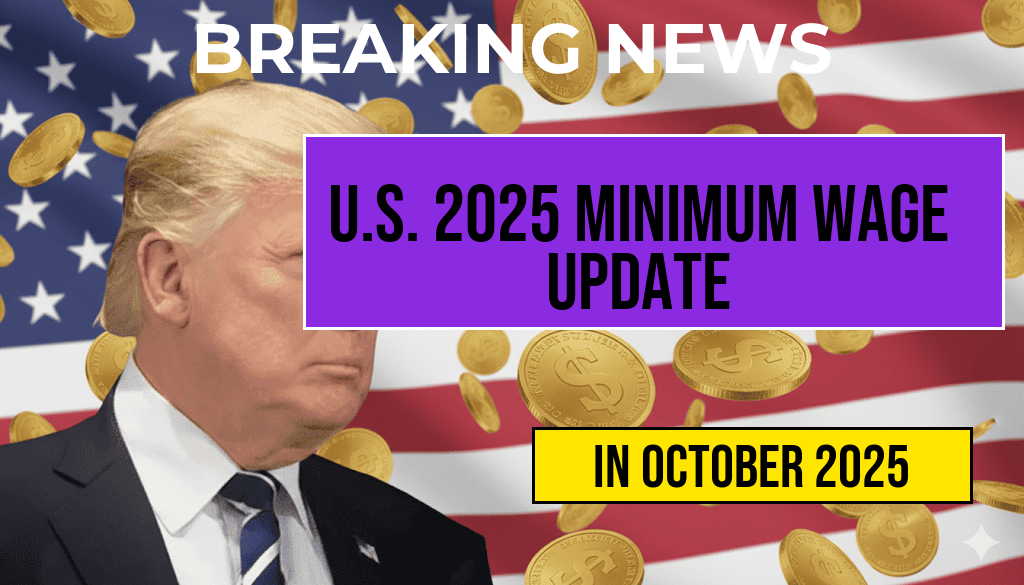The United States is implementing a significant update to its federal minimum wage effective October 4, 2024, with the new hourly pay rates set for 2025. This adjustment marks an important step in the ongoing effort to align wages with inflation and economic conditions, impacting millions of workers across various sectors. The federal minimum wage will increase from its current rate of $7.25 per hour to $8.50 per hour nationwide, reflecting a 17.2% rise. Several states and localities also announced their own increases for 2025, often exceeding federal adjustments, leading to a patchwork of wages across the country. Employers, workers, and policymakers are closely watching how these changes will influence hiring, inflation, and overall economic stability in the coming year. This article explores the details of the new minimum wage rates, regional variations, and the broader implications for the American labor market.
Federal Minimum Wage Rise for 2025
Key Facts and Timeline
| Effective Date | Current Rate | New Rate |
|---|---|---|
| October 4, 2024 | $7.25 | $8.50 |
The federal minimum wage, established by the Fair Labor Standards Act (FLSA), has remained at $7.25 since 2009. However, recent legislative efforts and economic analyses have prompted a series of increases scheduled over the next few years. The upcoming rise to $8.50 represents the first step in a phased plan to reach $10.75 by 2026, with subsequent adjustments tied to inflation and economic conditions. The U.S. Department of Labor has confirmed that the new rate will take effect on October 4, 2024, aligning with the start of the fiscal year and prompting employers nationwide to update their payroll systems accordingly.
Regional and State-Level Variations
States Leading the Way
While the federal minimum wage sets a baseline, many states and cities have their own minimum wage laws, often higher than the federal rate. For 2025, several jurisdictions have announced increases that surpass the federal adjustment, reflecting local economic conditions and policy priorities. For example:
- California will raise its minimum wage to $16.00 per hour for large employers, with smaller businesses reaching $15.00.
- New York is increasing its minimum wage to $15.75 in New York City, with regional rates varying across the state.
- Washington will bump wages to $15.74 for most workers, aligning with its phased approach to a $15 minimum.
Impact on Employers and Workers
Organizations across different sectors are preparing for these changes, which could influence hiring practices, operational costs, and pricing strategies. Small businesses, in particular, express concern over wage hikes, citing potential challenges in maintaining profitability. Conversely, advocates argue that higher wages can boost consumer spending and reduce reliance on social safety net programs.
Economic and Policy Implications
Market Response and Employment Trends
Economists are divided on the immediate effects of the wage increase. Some predict a modest uptick in consumer expenditure but caution about potential job slowdowns in low-wage industries. Historical data suggests that moderate increases in the minimum wage have not led to significant employment declines, but regional economic conditions and industry-specific factors play critical roles. The Congressional Budget Office (CBO) estimates that raising the minimum wage to $15 by 2025 could lift approximately 1.3 million Americans out of poverty, though some employment effects remain uncertain. For more details, see Wikipedia’s page on minimum wage in the U.S..
Legal and Political Landscape
While the federal adjustment is largely procedural, ongoing debates about wage policy continue to shape the legislative environment. Some states are pushing for even higher minimum wages, citing the rising cost of living. Conversely, opponents argue that mandated wage hikes could lead to increased automation or job cuts, particularly in sectors like retail and hospitality. Recent legal battles and ballot initiatives reflect a broader national conversation about fair wages and economic equity.
Summary of 2025 Minimum Wage Rates by State and Locality
| State or City | 2025 Minimum Wage | Notes |
|---|---|---|
| California | $16.00 | Large employers |
| New York | $15.75 (NYC) | Regional variations apply |
| Washington | $15.74 | Phased increase |
| Florida | $11.00 | Statewide minimum wage |
| Texas | $7.25 | Federal minimum applies |
As the country transitions into 2025, the landscape of wages continues to evolve, reflecting both federal directives and local priorities. Employers and employees alike will need to adapt to these shifts, which may influence economic growth trajectories and labor market dynamics in the months ahead. For further updates on wage policies, consult official sources such as the U.S. Department of Labor.
Frequently Asked Questions
What is the new minimum wage rate effective October 4, 2024?
The U.S. minimum wage will increase to $15.00 per hour nationwide starting October 4, 2024, marking a significant update for workers across various states and industries.
Which states are affected by the 2025 minimum wage increase?
The minimum wage increase applies to multiple states, with some implementing the $15.00 per hour rate, while others follow their own scheduled increases. It’s important to check specific state regulations for detailed information.
Will the minimum wage increase affect federal employees and contractors?
Yes, the federal minimum wage increase impacts federal employees and contractors, ensuring they receive the updated $15.00 per hour wage rate effective October 4, 2024.
Are there any exemptions or special considerations for certain industries?
Some industries or job roles may have specific exemptions or different wage standards due to existing laws or agreements. Employers should review applicable regulations to ensure compliance with the new minimum wage.
How will this wage increase impact workers and employers?
The wage increase aims to improve worker compensation and support living standards, while employers may need to adjust payroll and budgeting to accommodate the new minimum wage starting October 4, 2024.






